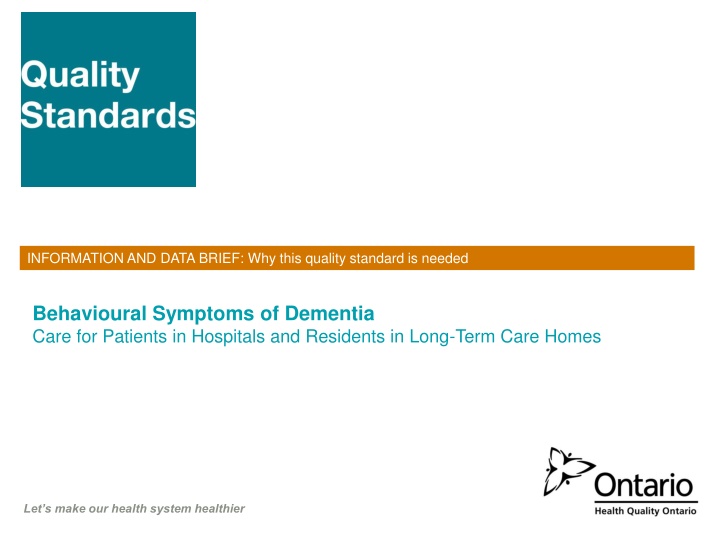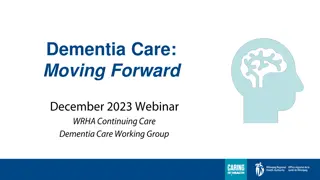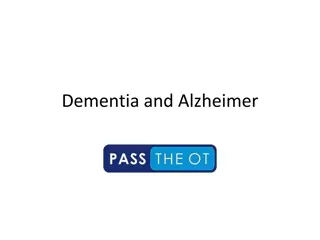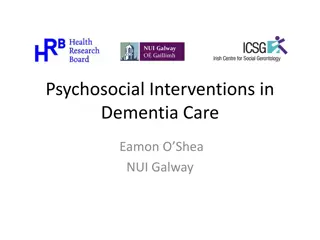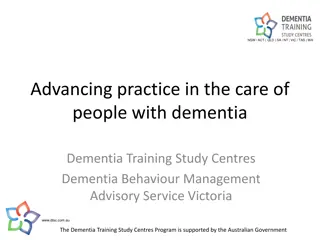Behavioural Symptoms of Dementia
Providing insights on the need for a quality standard addressing behavioural symptoms of dementia care in hospitals and long-term care homes. Highlighting data showing the necessity for improved care and how this standard aids in assessing and enhancing care quality.
Download Presentation

Please find below an Image/Link to download the presentation.
The content on the website is provided AS IS for your information and personal use only. It may not be sold, licensed, or shared on other websites without obtaining consent from the author.If you encounter any issues during the download, it is possible that the publisher has removed the file from their server.
You are allowed to download the files provided on this website for personal or commercial use, subject to the condition that they are used lawfully. All files are the property of their respective owners.
The content on the website is provided AS IS for your information and personal use only. It may not be sold, licensed, or shared on other websites without obtaining consent from the author.
E N D
Presentation Transcript
INFORMATION AND DATA BRIEF: Why this quality standard is needed Behavioural Symptoms of Dementia Care for Patients in Hospitals and Residents in Long-Term Care Homes Let s make our health system healthier www.HQOntario.ca
What Are Quality Standards Concise sets of easy-to-understand statements outlining what care should look like for people living with certain conditions and being cared for in specific settings Based on the best available evidence Designed for health care providers to know what care they should be offering To also help patients, residents, families and caregivers know what to ask for in their care www.HQOntario.ca 1
The Purpose of this Brief More than 200,000 people over the age of 65 in Ontario are living with dementia [1] Many experience behavioural symptoms of agitation and aggression and are cared for in hospitals and long-term care homes This brief provides information and data demonstrating why a quality standard is needed for people experiencing behavioural symptoms of dementia Specifically, it provides performance data on indicators that reflect the care received by people in long-term care homes, where a substantial number of residents are living with dementia - 66% or 47,340 people [2] [1] Alzheimer Society Ontario. 2012. Dementia Evidence Brief: Ontario. Toronto, Ontario. [2] Continuing Care Reporting System (CCRS), provided by the Canadian Institute for Health Information (CIHI) www.HQOntario.ca 2
The Purpose of this Brief The indicators included are not specifically limited to the population with dementia, but do reflect care that residents with dementia may receive and care that is described in the quality standard The data demonstrate that care for people living in long-term care homes who may have dementia and be experiencing behavioural symptoms needs to be improved That is why this quality standard has been created: To inform clinicians and organizations what high-quality health care for people living with this condition should look like To help clinicians and organizations assess the quality of care they are delivering, so they can identify gaps and areas for improvement www.HQOntario.ca 3
How We Look at the Data When available, the information presented reflects different perspectives Provincial results over time offer a broad overall system view Results by LHIN region highlight some of the local differences The distribution of the results across facilities provides some points of reference to the service providers www.HQOntario.ca 4
THE DATA www.HQOntario.ca
Some Context Because one of the quality standard aims is to improve behavioural symptoms such as agitation or aggression among people living with dementia who are experiencing such symptoms, we examine the percentage of individuals with improved behavioural symptoms in long-term care homes. www.HQOntario.ca 6
Only 12.4% of long-term care home residents experienced improved behavioural symptoms. This proportion has not improved in the last four years. Percentage of long-term care home residents who experienced improved behavioural symptoms, in Ontario, 2011/12 to 2015/16 www.HQOntario.ca 7
The percentage of long-term care home residents whose behavioural symptoms improved varies across LHIN regions, ranging from 9.6% of residents to 14.0%. Percentage of long-term care home residents who experienced improved behavioural symptoms, in Ontario, by LHIN region, 2015/16 www.HQOntario.ca 8
The percentage of long-term care residents who showed improvement in behavioural symptoms ranged from 0.5% to 30.7%. Percentage of long-term care home residents who experienced improved behavioural symptoms, in Ontario, by long-term care home, 2015/16 www.HQOntario.ca 9
Some Context Because the quality standard recommends that residents living with dementia who experience behavioural symptoms should be prescribed non-drug treatments first, and that medications should be prescribed only if residents are in severe distress (or if there is a concern they might harm themselves or someone else), we examine the percentage of long-term care home residents with no recorded diagnosis of psychosis who were prescribed antipsychotic medication in the seven days preceding their resident assessment, and who did not have a diagnosis of psychosis. www.HQOntario.ca 10
The percentage of long-term care home residents without psychosis using antipsychotic medications has decreased over the past four years. Percentage of long-term care home residents without psychosis using antipsychotic medications, in Ontario, 2011/12 to 2015/16 www.HQOntario.ca 11
The percentage of long-term care residents without psychosis using antipsychotic medications varied from 19.1% to 27.0% across LHIN regions. Percentage of long-term care home residents without psychosis using antipsychotic medications, in Ontario, by LHIN region, 2015/16 www.HQOntario.ca 12
Across long-term care homes, the percentage of residents without psychosis using antipsychotic medications varied from 0.7% to 57.1%. Percentage of long-term care home residents without psychosis using antipsychotic medications, in Ontario, by long-term care home, 2015/16 www.HQOntario.ca 13
Some Context Because the quality standard recommends that residents living with dementia who are experiencing behavioural symptoms not be physically restrained, we examine the percentage of long-term care home residents who were physically restrained daily over the seven days preceding their resident assessment. www.HQOntario.ca 14
The percentage of long-term care home residents who were physically restrained on a daily basis decreased over the past four years. Percentage of long-term care home residents in daily physical restraints, in Ontario, 2011/12 to 2015/16 www.HQOntario.ca 15
The percentage of long-term care home residents who were physically restrained on a daily basis varied from 2.3% to 13.3% across LHIN regions. Percentage of long-term care home residents in daily physical restraints, in Ontario, by LHIN region, 2015/16 www.HQOntario.ca 16
The percentage of long-term care home residents who were physically restrained on a daily basis ranged from 0% to 43.2% across Ontario long-term care homes. Percentage of long-term care home residents in daily physical restraints, in Ontario, by long-term care home, 2015/16 www.HQOntario.ca 17
Additional Resources This Information Brief is intended to support the Behavioural Symptoms of Dementia Quality Standard, which can be found in full HERE www.HQOntario.ca 18
Acknowledgements Health Quality Ontario acknowledges and thanks Dr. Julie Auger for her review of this brief. Parts of this material are based on data and information compiled and provided by the Canadian Institute for Health Information (CIHI). However, the analyses, conclusions, opinions and statements expressed herein are those of the author, and not necessarily those of CIHI. www.HQOntario.ca 19
www.HQOntario.ca FOLLOW@HQOntario
